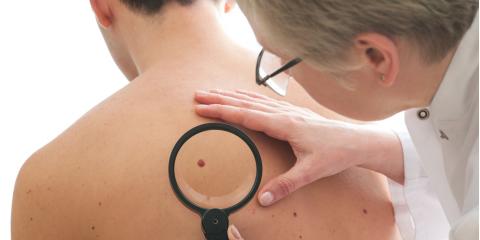
How to Check for Cancerous Moles
Moles are skin growths that usually have a black or brown appearance—typically, they’re harmless. However, Asheboro Dermatology & Skin Surgery Center in Asheboro and the Dermatology & SkinSurgery Centers in Pinehurst, Albemarle and Thomasville, NC, reminds patients that it’s important to be cautious of new moles or changing moles, as they may be an indicator of skin cancer. That’s why the providers at Asheboro Dermatology thoroughly and regularly screens for cancerous moles—and recommend you take action when warning signs are present.
Guide to Screening for Cancerous Moles
Perform Regular Self-Skin Checks
The best way to monitor for cancerous moles is to perform routine analysis on your own. You should give your whole body a look every month to check for new moles, changing moles and skin changes. Self-screening is best done after bathing and should be done in front of a full-length mirror while using a hand mirror to check hard-to-see areas. Be sure to check under skin folds, behind the thighs, and on the back and feet. During your skin check, you may notice new moles. If the mole is symmetrical (regular borders), small, and round, it is most likely a normal mole—but you should keep an eye on it for changes. Cancerous moles are identified by characteristics that are often grouped together by the “ABCDE” mnemonic. You should look for moles that have:
- Asymmetrical shapes
- Borders that are rough or irregular
- Colors varying in shades of brown, black, blue, white, or red
- Diameters larger than a pencil’s eraser
- Evolving characteristics, such as shape or size
 When to See a Dermatologist
When to See a Dermatologist
If you notice any “ABCDE” characteristics, you should make an appointment with a dermatologist. You should also make an appointment if a mole is painful, tender to touch, discharging fluids, or bleeding. Treating Cancerous Moles There is a lot that can be done to reduce the spread of skin cancer. However, early treatment is the best way to lower your need for future treatment. Depending on the extent of the cancer, your dermatologist may recommend skin excision to remove the mole or Mohs surgery—a precise method of removing all cancer cells while keeping healthy skin cells intact.
If you’re concerned about potentially cancerous moles, Asheboro Dermatology & Skin Surgery Center offers exceptional care and diagnostic services in Randolph, Moore and surrounding Counties. Visit their website to learn more about the skin treatments they offer. To schedule an appointment at their Asheboro, NC, location, call (336) 625-8410. If you live near Pinehurst, NC, you can schedule a visit by calling (910) 673-8410. Albemarle, NC, call (704) 982-8410 and Thomasville, NC, call (336) 475-8410 to schedule visits.
